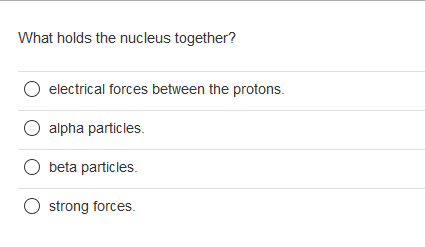The atomic nucleus, a fundamental component of matter, is primarily composed of protons and neutrons, collectively referred to as nucleons. At first glance, one might wonder why these positively charged protons do not repel each other, given that like charges exert a force that drives them apart. The phenomenon of nuclear stability arises not merely from the charges of these particles, but from a complex interplay of various fundamental forces that govern their interactions. In this discourse, we will delve into the mechanisms that hold the nucleus together, beginning with the fundamental forces, progressing through the role of nuclear binding energy, and concluding with implications in nuclear stability and radioactivity.
At the most elementary level, the forces at work within the nucleus can be categorized into several distinct types. The most prominent among these is the strong nuclear force. This force operates at a short range—typically on the order of a few femtometers (1 femtometer = 10-15 meters)—and is extraordinarily powerful, overcoming the electromagnetic repulsion between the positively charged protons. The strong nuclear force is mediated by particles called gluons, which bind quarks together to form protons and neutrons. Each nucleon, in turn, is composed of three quarks, held together by the exchange of gluons. The intricacies of this force manifest in various ways, including the binding of nucleons within the nucleus, cementing them firmly despite their electromagnetic repulsion.
Complementing the strong nuclear force is the weak nuclear force, albeit with a distinct role. While the strong force binds nucleons together, the weak force is responsible for processes such as beta decay, a type of radioactive decay that involves the transformation of a neutron into a proton (or vice versa). This force is essential in explaining certain types of nuclear reactions and has significant implications for the stability of isotopes within the nucleus. Although its influence is substantially weaker than that of the strong force, its role in nuclear transformation cannot be overlooked, as it dictates the interactions that lead to elemental transmutation.
Binding energy is the key concept that unifies our understanding of the forces at play within the nucleus. Defined as the energy required to disassemble a nucleus into its constituent nucleons, binding energy is a direct result of the strong nuclear force acting between nucleons. A higher binding energy typically correlates with greater stability of a nucleus. For instance, iron-56 exhibits one of the highest binding energies per nucleon, which is integral to its abundance in the universe. In contrast, nuclei that exhibit lower binding energies are more susceptible to decay, as they are less energetically favorable configurations.
The concept of mass defect also emerges when discussing binding energy. According to Einstein’s mass-energy equivalence principle (E=mc2), the mass of a nucleus is less than the sum of its individual nucleon masses. This discrepancy arises because some of the mass is converted to energy during the process of nucleon binding. The loss of mass—termed the mass defect—can be quantitatively analyzed using binding energy calculations. This phenomenon underscores the profound relationship between mass and energy in nuclear physics and illustrates the stability afforded by the binding energy of nucleons.
The interplay of these forces culminates in various nuclear configurations, each with its specific stability characteristics. For instance, atomic isotopes with equal numbers of protons but varying numbers of neutrons exhibit differing binding energies and stability. The liquid drop model provides a heuristic framework to conceptualize these effects, likening the nucleus to a droplet of incompressible fluid. It helps to elucidate how surface tension and volume energy of nucleons contribute to the nucleus’s overall binding energy. Furthermore, the shell model describes nucleons as occupying quantized energy levels, akin to electrons in atomic orbitals. This model assists in explaining the magic numbers—specific numbers of nucleons that lead to particularly stable configurations. Understanding these characteristics lays the groundwork for predicting the behavior of elements during nuclear reactions.
Additionally, the stability of the nucleus is contingent on several factors, such as the neutron-to-proton ratio. Stable nuclei typically have a balanced ratio, whereas nuclei with an excess of either neutrons or protons may exhibit tendencies towards instability and subsequent decay. Such instability is often revealed through the processes of alpha, beta, and gamma decay, with implications for a range of applications from nuclear power generation to medical therapies. In essence, these decay processes illustrate the dynamic equilibrium of forces within the nucleus, as unstable combinations of nucleons seek lower energy states.
In the realm of nuclear physics, understanding what holds the nucleus together extends beyond mere academic inquiry; it has real-world implications. The principles underlying nuclear forces inform the development of nuclear weapons, nuclear energy systems, and medical technologies, including radiation therapy for cancer treatment. Moreover, the quest to comprehend the fundamental forces within the nucleus invites a broader exploration of the universe itself, as the interactions of particles at the atomic level shape the very fabric of matter and the cosmos.
In conclusion, the stability of the atomic nucleus is a profound result of multiple interwoven forces, predominantly the strong nuclear force, supplemented by the weak nuclear force and binding energy considerations. These elements collectively elucidate the mechanisms that maintain the integrity of the nucleus amidst the tumultuous forces at play. A deeper understanding of these interactions is vital, as they underpin much of modern physics and affect a myriad of technological developments.












